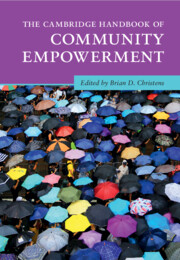Book contents
- The Cambridge Handbook of Community Empowerment
- Cambridge Handbooks in Psychology
- The Cambridge Handbook of Community Empowerment
- Copyright page
- Contents
- Figures
- Tables
- Contributors
- Building Community Power
- Part I Organizing and Activism
- Part II Participatory Governance
- 7 Citizens’ Governance Spaces
- 8 Participatory Budgeting
- 9 Participatory Urban Planning
- 10 Youth Policy Advocacy in Municipal Governance
- Part III Civil Society and Coalitions
- Part IV Enterprise
- Part V Participatory and Community Arts
- Part VI Education and Engaged Research
- Contributor Details
- Index
- References
10 - Youth Policy Advocacy in Municipal Governance
from Part II - Participatory Governance
Published online by Cambridge University Press: 18 April 2024
- The Cambridge Handbook of Community Empowerment
- Cambridge Handbooks in Psychology
- The Cambridge Handbook of Community Empowerment
- Copyright page
- Contents
- Figures
- Tables
- Contributors
- Building Community Power
- Part I Organizing and Activism
- Part II Participatory Governance
- 7 Citizens’ Governance Spaces
- 8 Participatory Budgeting
- 9 Participatory Urban Planning
- 10 Youth Policy Advocacy in Municipal Governance
- Part III Civil Society and Coalitions
- Part IV Enterprise
- Part V Participatory and Community Arts
- Part VI Education and Engaged Research
- Contributor Details
- Index
- References
Summary
This chapter provides a comprehensive overview of the scholarly literature on youth engagement in policy advocacy in the context of municipal youth councils. First, the organizational structure, membership, and activities of youth councils are presented. Then, the prevalence and trends of youth councils in the US and internationally are discussed. A case exemplar of the Boston Mayor’s Youth Council and its youth-led participatory budgeting process is presented to illuminate key principles and practices of municipal youth councils, including the benefits and barriers of youth engagement on youth and communities. Then, the literature pertaining to power and empowerment processes in youth policy advocacy is reviewed, including key features of youth councils that can facilitate or impede psychological empowerment and community power. The chapter concludes with a review of implications for practitioners, leaders, policymakers, funders, and other stakeholders, as well as areas for future research.
- Type
- Chapter
- Information
- The Cambridge Handbook of Community Empowerment , pp. 262 - 286Publisher: Cambridge University PressPrint publication year: 2024



